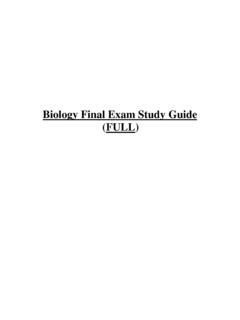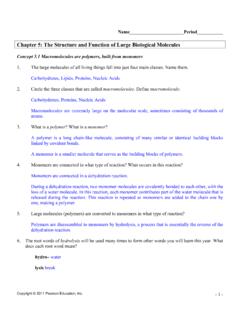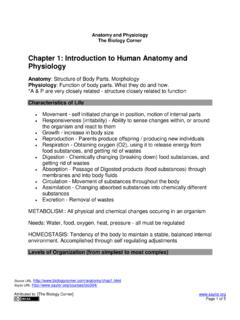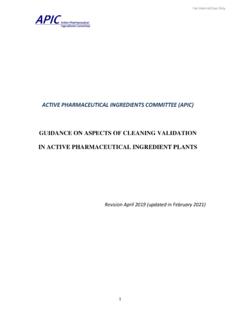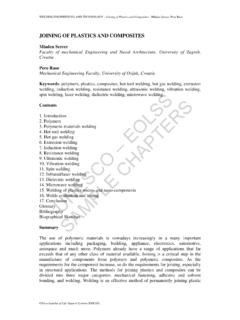Search results with tag "Macromolecules"
Biology Final Exam Study Guide (FULL)
www.oocities.orgMacromolecules – A giant molecule formed by the joining of smaller molecules, usually by a condensation reaction. Polysaccharides, proteins, and nucleic acid are macromolecules. *Macromolecules are polymers that are built from monomers. Polymer – long molecule consisting of many similar or identical building blocks linked by covalent bonds.
CHAPTER SOLUTIONS - Elsevier.com
booksite.elsevier.commacromolecules such as proteins, lipids, nucleic acids, and carbohydrates. These biochemical macromolecules are bu ilt simpler molecules such as carbon chains and amino acids. When studying at on e of these levels of abstraction, bi-ologists are usually interested in the levels above and below: what the structures
Chapter 5: The Structure and Function of Large Biological ...
www.pearlandisd.orgConcept 5.1 Macromolecules are polymers, built from monomers 1. The large molecules of all living things fall into just four main classes. Name them. Carbohydrates, Lipids, Proteins, Nucleic Acids 2. Circle the three classes that are called macromolecules. Define macromolecule. Carbohydrates, Proteins, Nucleic Acids
Carbohydrates, Lipids, Proteins, Nucleic Acids
mrsgiegler.weebly.comMacromolecules Macromolecules are made up of smaller pieces One of these pieces by itself is called a monomer “Mono” - one Monomer – one unit/building block of a macromolecule Putting many monomers together results in a polymer “Poly” – many Polymer – many units/building blocks hooked together
Answers - AP Biology 2015-2016
apbio1516.weebly.comDec 07, 2015 · c, If you wanted to label only the DNA, what compound(s) could you label? You could label either deoxyribose or thymine., Based on your answers to questions 1-7, what simple rule(s) can you use to identify the following macromolecules?
Chapter 1: Introduction to Human Anatomy and Physiology
resources.saylor.orgMacromolecules --> Organelles --> Cells --> Tissues --> Organs --> Organ Systems --> Organism *A group (mass) of cells working together to carry out certain common functions form a tissue *A group of tissues working together to carry out certain common functions form an organ
RECOMMENDATION LETTER : AFTER - TopAdmit
www.topadmit.commacromolecules using the latest research. I was excited about his interest and fully supported his decision. In summary, Mr. is a very hardXXXX -working and ambitious student who is committed to expanding his theoretical and experimental knowledge in the field of …
CHAPTERS 14/15: POLYMER STRUCTURES, APPLICATIONS, & …
www3.nd.eduPOLYMERS • A polymer is a macromolecule (long molecules) built of small covalently bonded units called monomers (“mer” from the Greek word meros meaning part). • These small units are repeated throughout the macromolecule chain. • The macromolecules are bonded together by weak Van der Waals
ACTIVE PHARMACEUTICAL INGREDIENTS COMMITTEE …
apic.cefic.orgNote: for therapeutic macromolecules and peptides the determination of HBEL using PDE limits of the active and intact product may not be required (conform EMA CHMP/ CVMP/ SWP/169430/2012). An alternative approach is suggested in section 4.2.3.
Introduction to Three Dimensional Structure Determination ...
www.stat.uchicago.eduIntroduction to Three Dimensional Structure Determination of Macromolecules by Cryo-Electron Microscopy Amit Singer Princeton University, Department of Mathematics and PACM ... Three-dimensional Reconstruction: a 3D volume is generated by a tomographic inversion algorithm.
GRE BIOCHEMISTRY TEST PRACTICE BOOK
www.ets.orgSynthesis and degradation of macromolecules E.Bioenergetics Energy transformations at the substrate level . Electron transport Proton and chemical gradients . Energy coupling (e.g., phosphorylation, transport) 4 | Page G Biochemistry Cell …
Joining of Plastics and Composites - Encyclopedia of Life ...
www.eolss.netUNESCO – EOLSS SAMPLE CHAPTERS WELDING ENGINEERING AND TECHNOLOGY - Joining of Plastics and Composites - Mladen Sercer, Pero Raos ©Encyclopedia of Life Support Systems (EOLSS) polymeric welding technology only. 2. Polymers Polymers are a group of organic, semi-organic, or (rarely) inorganic chemical substances containing many large polymer molecules (macromolecules) often form
CHAPTER 12 INERAL NUTRITION - National Council of ...
ncert.nic.in194 BIOLOGY The basic needs of all living organisms are essentially the same. They require macromolecules, such as carbohydrates, proteins and fats, and
MACROMOLECULES PRACTICE TEST MULTIPLE CHOICE
www.wsfcs.k12.nc.usMACROMOLECULES PRACTICE TEST MULTIPLE CHOICE 1. The molecule below is a a. carbohydrate b. lipid c. steroid d. A and C e. B and C 2. The molecule below is a polymer of glucose monomers. The molecule below is a. Cellulose b. Starch c. …
Macromolecules Chart - hudson.edu
www.hudson.eduMacromolecules Chart Macromole cule (polymer) Functional Groups, Basic Formula Monomer Subgroups Examples Uses Carbo-hydrates C:H:O 1:2:1 Mono-saccharide Monosaccharides-simple sugars Disaccharides-double sugars Polysaccharides-many sugars Glucose,fructose, galactose Sucrose Starch-plants Glycogen-animals Cellulose-plants Chitin-insects Energy
Similar queries
MACROMOLECULES, POLYMERS, Carbohydrates, Macromolecules Macromolecules, 2015, ACTIVE PHARMACEUTICAL INGREDIENTS COMMITTEE, Introduction to Three Dimensional, Introduction to Three Dimensional Structure Determination of Macromolecules, Three, Dimensional, Biochemistry Cell, Joining of Plastics and Composites, CHAPTER 12 INERAL NUTRITION, Macromolecules Chart
